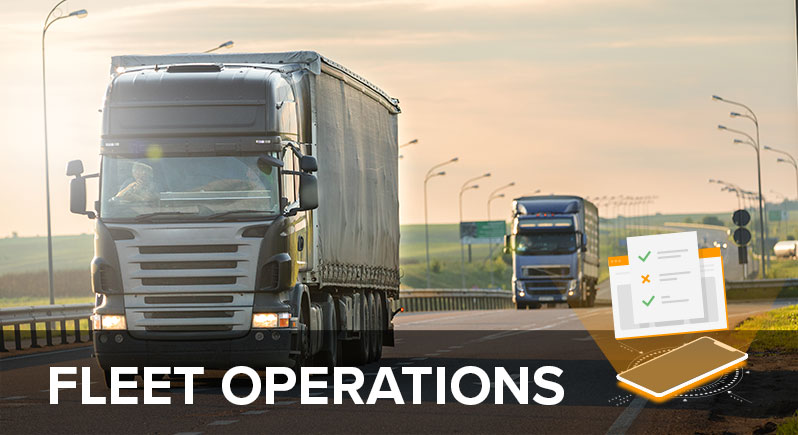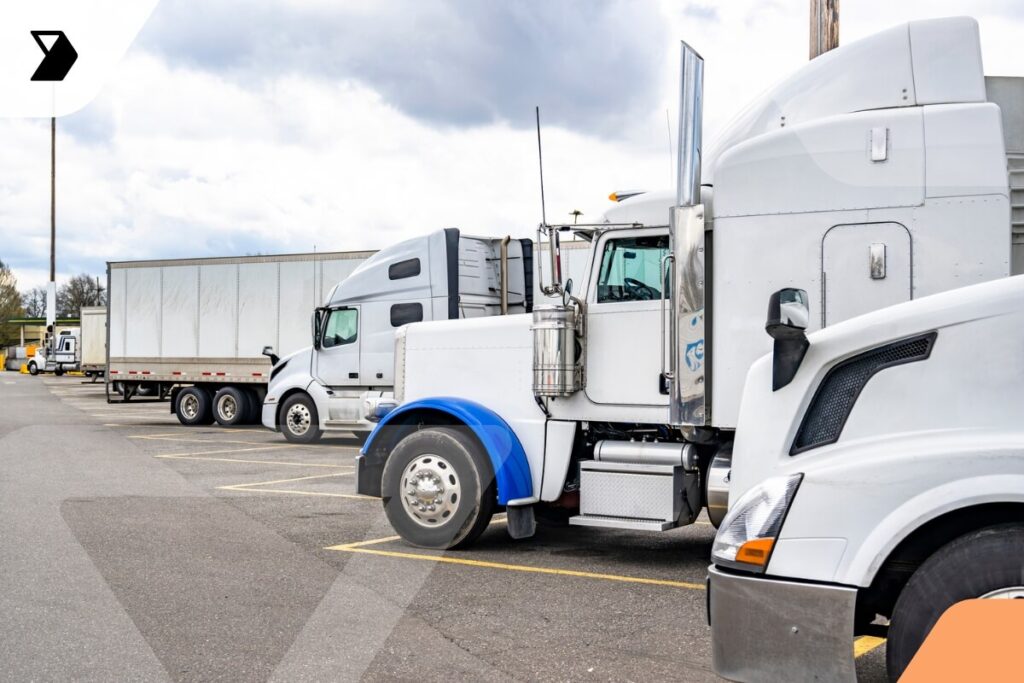Here’s Your DOT Audit Checklist so You Can Be Sure to Pass
So you drew the shortest straw. You must go through a DOT (U.S. Department of Transportation) audit process.
Ready to transform your supply chain?

Don’t panic! Yes, DOT audits cause stress, anxiety, and a lot of data retrieval. Also, they take time. They can sap resources, hurt your relationships, and even put you out of business.

But there are things you can do to make an audit less painful.
This post will help you prepare for your DOT audit. Here, we’ll cover the audit basics. I’ll also provide a complete DOT audit checklist so you can be sure to pass with flying colors.
First of all, be aware that DOT audits occur with little to no advance notice. The level of pain an audit creates directly correlates to your company’s organization, bookkeeping, and document management. That means every carrier realistically needs to be prepared for an audit at any time. It also means there’s no better time to prepare for your next audit than right now. Let’s go!
The Four Types of DOT Audits
The DOT auditor is looking for two main things: First, that you have a system in place to ensure you stay in compliance with all DOT regulations. And second, that your document management system captures, organizes, and stores all the information that the DOT requires of carriers.
Here are the different types of government transportation audits:
- New entrant safety audit (NESA): This usually takes place within the first six months of being in business. It’s designed to be comprehensive and ensure compliance with all required safety regulations.
- Compliance review: This one makes sure you’re following all DOT regulatory processes. Also, it looks at your company’s safety performance.
- Security audit: This specifically looks at your safety plan, driver training, and company security measures. It often goes hand in hand with the Hazardous Material audit.
- Hazardous material audit: It specifically reviews hazardous material training, policy, shipping documentation, placards, markings, and container labeling.
Digital Docs
Regardless of whether you’re a new entrant or veteran carrier, the key to passing your audit is keeping good records all year round. In the past, carriers had no choice but keep tons of paper records in an ever-expanding stack of filing cabinets just to remain DOT compliant. But the industry trend has moved toward digital document management and cloud-based storage. As a result, maintaining organized records and preparing for a DOT audit has never been easier.
That being said, if you want to be sure to pass your audit, the first item on your DOT audit checklist needs to be your attitude.
Auditors know every company makes mistakes. They’re looking for improvement. You need to show the auditor a willingness and desire to attack and fix any issues that arise. Thus, a respectful attitude toward the auditor can carry you further than you imagine. Remember, a spoonful of sugar helps the medicine go down.
A Note About the NESA
If you’re a new entrant, you’re literally asking to be audited. To become a new entrant, you already filed your MCS-150 “Combined Motor Carrier Identification Report” and OP-1 series form. You received your DOT identification number. You’re legally able to operate in interstate commerce. Now comes the next major hurdle. Along with growing a new business, you must also prepare for your NESA.
Within the first 12 months that you’re operating under a DOT identification number, you will be audited. The new entrant period lasts 18 months. During this time, you as a new entrant must:
- Pass the NESA
- Operate safely
- Maintain up-to-date records
- Retain maintenance records on all commercial motor vehicles (CMVs)
A certified auditor will conduct your new entrant audit. It will occur either at your primary location, a third-party location, or electronically. If your audit is electronic, you’ll submit documents online by email or fax.
The trucking industry trend is to use more digital document capture and storage. Whether you’re just starting out or already established, I recommend getting your hands on elite document capture tech. Doing so will make day-to-day record-keeping—and the audit process—as painless as possible.
The Complete DOT Audit Checklist
The following DOT audit checklist will help make sure you pass any DOT audit, especially the all-encompassing NESA. Auditors will request information organized into three general categories. Make sure you address each item, as any noncompliance can trigger an audit failure. The future solvency of your business depends on it. In fact, you should also review the official audit requirements, resources, and sample forms on the FMCSA website.
- Drivers
- Vehicles
- Carrier- or Programmatic-Related Documents
Now that you know the three general categories, let’s examine each one in detail.
Drivers
What does the auditor need to know about your drivers? Have this information ready:
- Drivers List: For each driver, you must provide the name, date of birth, license number, license state, and date of hire.
- Driver’s Licenses: All drivers of commercial motor vehicle (CMVs) must have an active and compliant commercial driver’s license (CDL) or operator’s license (with all proper endorsements). Any driver exemptions also must be noted.
- Records of Duty (ROD) and Supporting Documentation: This encompasses your hours of service (HOS) tracking. It also ties in directly to the electronic logging device (ELD) requirement.
- Motor Vehicle Record (MVR) for Each Driver: You must request each driver’s MVR every 12 months and keep the record for three years.
- Certificate of Violations: This document must list all moving violations accrued for each driver in the previous 12 months.
- Driver’s Safety Performance History: You must either produce records for the previous three years or show a good-faith effort if a driver was at another employer.
- Medical Certificate: Carriers must provide documentation that every driver passed a physical given by a certified medical examiner. Drivers need to pass a physical at least every two years. Any waivers a driver has been granted (such as for diabetes or a limb prosthetic) must also be included in their file.
- Application for Employment: This document speaks to the background and character of a driver. It includes accident history, work history, and reasons for leaving past employers. Make note of the required information.
- Road Test and Entry Level Driver Training Documents: This document proves a driver passed a driving skills evaluation.
Let’s move on to what your auditor needs to know about your vehicles.
Vehicles
- Vehicle List: As you’d think, this is a list of all the vehicles in your fleet. For each vehicle, include its unit number, vehicle identification number (VIN), plate number, and registration state.
- Proof of Vehicle Inspections: Every CMV in the fleet must have documentation of a passed vehicle inspection in the prior 12 months.
- Proper Vehicle Markings: USDOT number, business name, should be visible on both sides of truck. Hazardous material carriers need to pay close attention to the marking requirements.
- Hazardous Materials Shipping Documents: If you ship hazardous materials, you must provide shipping papers and emergency response information for each load. Also, you must keep the hazardous material shipping documents on file for one year after acceptance of shipment. If the shipment is hazardous waste, you must keep documents for three years.
Now let’s look at the final category.
Carrier/Programmatic Documents
- Proof of Insurance: Every carrier must provide proof it has at minimum $750,000 of insurance. Keep in mind, this number can range up to $5 million based on whether you carry people or certain types of shipments, such as hazardous or heavy freight.
- Accident Register: Carriers involved in a reportable crash within the last 365 days must provide an accident register. After a crash, you must keep this report for three years.
- Drug and Alcohol Program: If you’re a carrier with CDL drivers, you must provide documentation of your drug and alcohol testing program. You must provide a report of pre-employment drug and alcohol tests. And you must also provide documents proving you have a random testing procedure that aligns with FMCSA regulations. Also, you need to provide a list of drivers in the random testing program. And finally, you must provide proof of your alcohol misuse prevention programs.
Automatic Failures
Some audit violations are considered extreme enough to trigger an automatic failure. Therefore, it might be a good idea to focus on these eight hot spots first and foremost:
- No (or insufficient) alcohol and/or drug testing program.
- Using a driver who refused an alcohol or drug test.
- Using a driver who didn’t properly follow up on failed alcohol or drug test procedures.
- Utilizing a driver who isn’t properly and actively licensed with a CDL.
- Using a driver who failed their medical examine.
- Operating a vehicle without the required level of insurance.
- Inadequate HOS records.
- Utilizing a vehicle without adequate inspection.
If you cover your bases in these eight areas, you’ll have a greater chance of passing your audit.
What happens after the audit?
Pass or Fail: Next Steps
Your auditor will review the findings of his or her audit with you. You will be notified of any violations, and you will receive guidance for how to correct those violations. The FMCSA will then send your official audit results in writing within 45 days, confirming whether you passed or failed.
If you fail, all is not lost! You’ll receive documentation indicating why you failed. Also, you’ll receive guidance for how to remedy the violations. In short, you must create what’s called a corrective action plan (CAP). Then get to work.
What happens if you fail to create or execute your CAP? The DOT will revoke your DOT registration.
If you pass, congratulations! If you’re a new entrant, the DOT will continue to monitor you closely for the balance of your 18-month new entrant period. Regardless, take this opportunity and do a little victory jig, because at this point your DOT carrier registration becomes permanent!
Best Practices
Beyond the NESA, the DOT also performs compliance reviews, security audits, and hazardous material audits on established carriers all the time. In general, the number of audits has been increasing lately as scrutiny and calls for safety increase. As already mentioned, with all audits, the pain involved directly relates to your level of document organization. If you want to make life easier, get your hands on high-quality document management technology. It will help streamline your daily workflow, your invoicing, and the document retrieval process required during every audit.
In Summary
DOT audits are serious. A failure can result in hefty fines, interfere with your insurance, disrupt your business relationships, and even shut down your company. The best way to mitigate the risk of an audit is to be prepared for one at all times, and to use a DOT Audit Checklist such as the one provided in this article to be sure that you are ready.
In short, do your future self a favor as if your livelihood depends on it. Invest in some strong document management tech, and get organized today!
This post was written by Brian Deines. Brian believes that every day is a referendum on a brand’s relevance, and he’s excited to bring that kind of thinking to the world of modern manufacturing and logistics. He deploys a full-stack of business development, sales, and marketing tools built through years of work in the logistics, packaging, and tier-1 part supply industries serving a customer base comprised of Fortune 1000 OEMs.
Continue reading
Ready to transform your supply chain?
Increase efficiency and productivity. Say goodbye to delays, handwriting errors, and time-intensive manual data entry.



